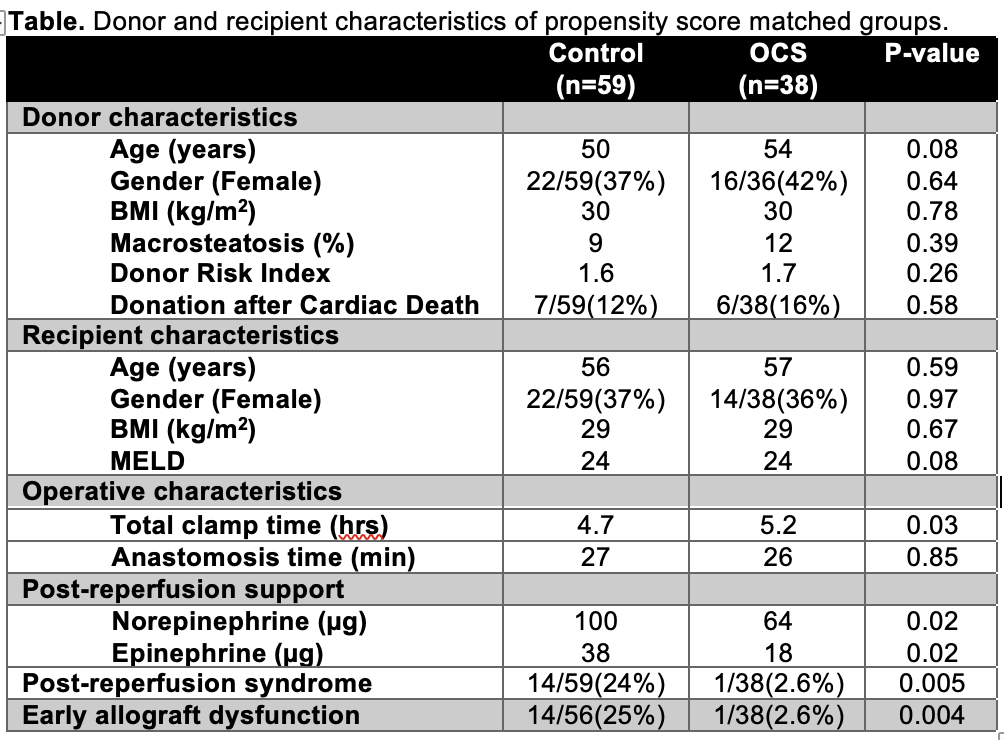Controlling Instability at Reperfusion: Another Benefit of Normothermic Machine Perfusion Using OCS Liver
1Surgery, University of Texas Southwestern Medical Center, Dallas, TX, 2Anesthesia, University of Texas Southwestern Medical Center, Dallas, TX, 3University of Texas Southwestern Medical Center, Dallas, TX, 4TransMedics, Andover, MA
Meeting: 2022 American Transplant Congress
Abstract number: 440
Keywords: Hemodynamics, Liver, Machine preservation
Topic: Clinical Science » Organ Inclusive » 69 - Non-Organ Specific:Organ Preservation/Ischemia Reperfusion Injury
Session Information
Session Name: Surgical Issues: Donor and Recipient
Session Type: Rapid Fire Oral Abstract
Date: Tuesday, June 7, 2022
Session Time: 3:30pm-5:00pm
 Presentation Time: 4:10pm-4:20pm
Presentation Time: 4:10pm-4:20pm
Location: Hynes Room 310
*Purpose: Organ Care System (OCS) Liver is a portable ex-vivo normothermic liver perfusion device recently shown to provide superior donor organ preservation. The impact of OCS Liver on post-reperfusion syndrome (PRS) remains unknown.
*Methods: This was a retrospective, single center, case-control study. All transplants utilizing OCS Liver between 1/1/2018 and 12/31/2020 were compared with a propensity score matched (PSM) cohort . The control population was matched for age, MELD, donor type and ventilator/circulatory support. Multiorgan transplants were excluded from the analysis. Donor, procurement, and recipient characteristics were collected for all recipients. Anesthesia records containing vitals by minute and pressor/inotropes were collected to establish baseline (5 minutes prior to reperfusion) and up to 30 minutes post-reperfusion hemodynamics.
*Results: Following PSM there were 97 liver transplants in the study cohort, including 38 OCS (39%) and 59 controls (61%). Donor and recipient characteristics confirmed these groups were well matched (Table). PRS, defined by ≥1 minute of mean arterial pressure 30% below baseline, was significantly reduced in the OCS group (1/38(3%) vs. 14/45(24%), p=0.005). OCS patients required significantly less post-reperfusion support, where both total norepinephrine (64 µg vs. 100 µg, p=0.02) and total epinephrine (18 µg vs. 38 µg, p=0.02) infusions were reduced compared to controls. Patients with combined blood pressure instability and pressor support were more likely to develop early allograft dysfunction (EAD), (15/56(27%) vs. 0/38(0%), p=0.001). However, the use of OCS was associated with a 10-fold reduction in EAD (1/38(2.6%) vs. 14/56(25%), p=0.004).
*Conclusions: Normothermic machine perfusion using OCS Liver reduces hemodynamic instability after reperfusion and also results in a significantly reduced incidence of EAD.
To cite this abstract in AMA style:
Hwang CS, Shi C, Patel M, Shah J, DeGregorio L, Hanish S, Kadakia Y, Chaudhary U, Okoro E, Cheruku S, Lahsaei P, Vagefi P, MacConmara M. Controlling Instability at Reperfusion: Another Benefit of Normothermic Machine Perfusion Using OCS Liver [abstract]. Am J Transplant. 2022; 22 (suppl 3). https://atcmeetingabstracts.com/abstract/controlling-instability-at-reperfusion-another-benefit-of-normothermic-machine-perfusion-using-ocs-liver/. Accessed December 15, 2025.« Back to 2022 American Transplant Congress

